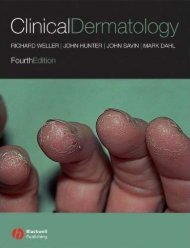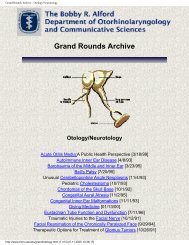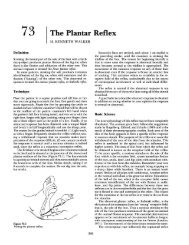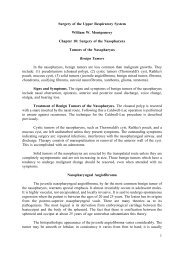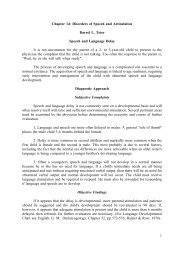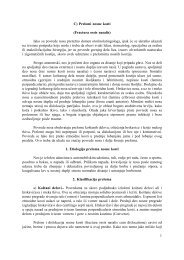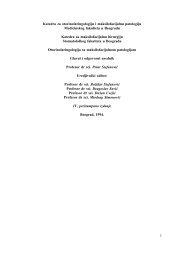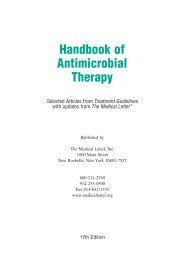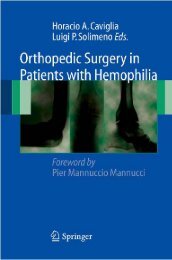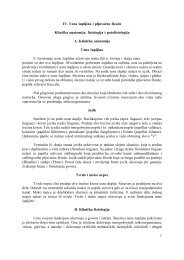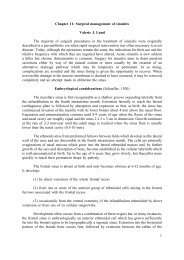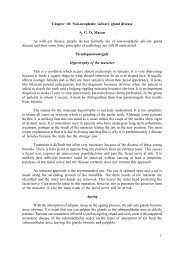1 Chapter 13: Acute suppurative otitis media and acute mastoiditis ...
1 Chapter 13: Acute suppurative otitis media and acute mastoiditis ...
1 Chapter 13: Acute suppurative otitis media and acute mastoiditis ...
You also want an ePaper? Increase the reach of your titles
YUMPU automatically turns print PDFs into web optimized ePapers that Google loves.
There may be a history of one or more of the predisposing factors described under<br />
aetiology.<br />
Signs<br />
Before describing these it is important to consider the method of examining young<br />
children. It is of the utmost importance to gain their confidence as there may be only one<br />
chance to examine them - an abortive or clumsy attempt at otoscopy may result in a<br />
distraught <strong>and</strong> terrified child who will not submit to examination a second time. Children can<br />
be thought of as miniature adults with their own name <strong>and</strong> distinctive personality, <strong>and</strong> their<br />
own (sometimes inappropriate) views as to how the consultation should be conducted. They<br />
fear pain <strong>and</strong> the unknown, <strong>and</strong> should therefore be examined with the utmost gentleness,<br />
speaking to the child by name <strong>and</strong> reassuring him that by keeping still the examination will<br />
not be painful. The best position for examination is on the mother's lap: she holds the child's<br />
head against her chest with one h<strong>and</strong> on his forehead, <strong>and</strong> with her other h<strong>and</strong> restrains his<br />
arms. If possible the child's legs should be held firmly by the mother between her thighs.<br />
Ears<br />
In the early stages of <strong>acute</strong> <strong>suppurative</strong> <strong>otitis</strong> <strong>media</strong> the tympanic membrane will be<br />
injected along the h<strong>and</strong>le of the malleus, around the periphery, <strong>and</strong> sometimes over the pars<br />
flaccida. Later the whole tympanic membrane becomes hyperaemic <strong>and</strong> opaque. If infection<br />
continues <strong>and</strong> pus begins to accumulate under pressure, the pars tensa starts to bulge, mainly<br />
posteriorly, <strong>and</strong> acquires yellowish colour. Finally the tympanic membrane ruptures <strong>and</strong><br />
discharge will be seen in the external canal, which may be serous, serosanguineous,<br />
mucopurulent or frankly purulent. It is important to note whether the discharge has the shiny,<br />
glossy appearance of mucus - if the discharge contains mucus it can only come from the<br />
middle ear. The presence or absence of an offensive odour from the discharge should also be<br />
noted - if present it suggest underlying chronic <strong>otitis</strong> <strong>media</strong>. (See also Differential diagnosis<br />
below.) At this time the pain usually subsides. After mopping or aspirating discharge it is<br />
usually possible to see a small central perforation, commonly in the posterior segment of the<br />
pars tensa. Sometimes, however, the perforation may be difficult to see as the oedematous<br />
edges of the middle ear mucosa tend to obscure it. It may be located by applying a negative<br />
pressure with a Siegle's speculum, or aspirating under the operating microscope, when a blood<br />
or discharge may be seen emerging from the perforation. The perforation may also be<br />
anterior, but is only marginal or in the pars flaccida in <strong>acute</strong>-on-chronic middle ear disease.<br />
If the infection has followed trauma to the tympanic membrane a jagged perforation may be<br />
seen. If a ventilation tube is in situ, pus may be seen pulsating through the lumen.<br />
Mastoid tenderness, elicited by pressure over McEwen's triangle, may be present early<br />
in the course of <strong>acute</strong> <strong>suppurative</strong> <strong>otitis</strong> <strong>media</strong>. It assumes significance as a sign of <strong>mastoiditis</strong><br />
if it persists or increases despite adequate treatment.<br />
During resolution the hyperaemia fades <strong>and</strong> the perforation heals, often leaving no<br />
trace but sometimes leaving a scar.<br />
In older children <strong>and</strong> adults the Rinne <strong>and</strong> Weber tests will indicate conductive<br />
deafness. In younger children the hearing for a whispered voice will be impaired.<br />
7




